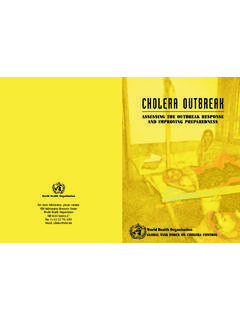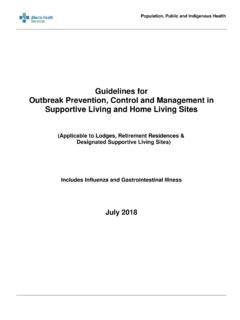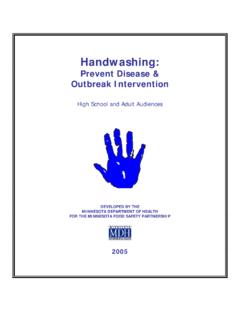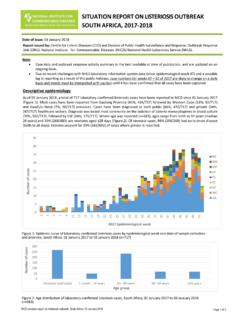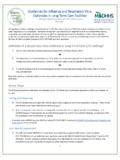Transcription of World Health Organization Outbreak …
1 World Health Organization Outbreak CommunicationPlanning Guide2008 EditionWorld HealthOrganizationWorld Health Organization Outbreak CommunicationPlanning Guide2008 EditionUSING THIS GUIDE .. 3 INTRODUCTION .. 4 The Planning Foundation: WHO Outbreak Communication Guidelines.
2 5 The Planning Challenge: Moving from Concept to Application .. 6 WHO Outbreak Communication Planning Steps .. 7 Planning Step 1: Assessment .. 8 Planning Step 2: Coordination .. 9 Planning Step 3: Transparency.
3 12 Planning Step 4: Listening during an Outbreak .. 15 Planning Step 5: Communication Evaluation .. 22 Planning Step 6: Constructing an Emergency Communication Plan .. 25 Planning Step 7: Training .. 29 GLOSSARY .. 30 TABLE of CONTENTS1 WHO Library Cataloguing-in-Publication DataWorld Health Organization Outbreak communication planning guide 2008 outbreaks.
4 Media. relations. Health 978 92 4 159744 9 (NLM classification: WA 110) World Health Organization 2008 All rights reserved. Publications of the World Health Organization can be obtained from WHO Press, World Health Organization , 20 Avenue Appia, 1211 Geneva 27, Switzerland (tel.: +41 22 791 3264; fax: +41 22 791 4857; e-mail: Requests for permission to reproduce or translate WHO publications whether for sale or for noncommercial distribution should be addressed to WHO Press, at the above address (fax: +41 22 791 4806; e-mail: The designations employed and the presentation of the material in this publication do not imply the expression of any opinion whatsoever on the part of the World Health Organization concerning the legal status of any country, territory, city or area or of its authorities, or concerning the delimitation of its frontiers or boundaries.))
5 Dotted lines on maps represent approximate border lines for which there may not yet be full mention of specific companies or of certain manufacturers products does not imply that they are endorsed or recommended by the World Health Organization in preference to others of a similar nature that are not mentioned. Errors and omissions excepted, the names of proprietary products are distinguished by initial capital reasonable precautions have been taken by the World Health Organization to verify the information contained in this publication. However, the published material is being distributed without warranty of any kind, either expressed or implied.
6 The responsibility for the interpretation and use of the material lies with the reader. In no event shall the World Health Organization be liable for damages arising from its use. Printed by the WHO Document Production Services, Geneva, Switzerland ObjectiveThe objective of this document is to help national authorities apply the WHO Outbreak Communication Principles to their Outbreak planning and preparation activities. This document addresses specific public Health objectives including: ensuring at-risk populations have the information they need to make well-informed decisions and to take appropriate actions to protect their Health and safety during an Outbreak ; supporting coordination and the efficient use of communication resources among local, national and international public Health partners; providing relevant public Health information to inform implicated non- Health sectors; minimizing social and economic disruption.
7 And, as an overarching goal before, during and after outbreaks, to maintain and build public trust in public Health UserNational public Health authorities are the intended users of this recommendations contained in this document build from the WHO Outbreak Communication Guidelines and, therefore, focus on infectious disease outbreaks. By following the recommendations set out in the document, however, an Organization will be building public communication capacity that will be useful in responding to public Health emergencies in general. Tools and Checklists: related WHO documentsAmong the most practical Outbreak communication planning and response steps is the integration of simple tools and checklists for specific public communication activities.
8 While not the focus of this document, several WHO resources are available which provide tools and checklists as well as in-depth consideration of specific public communications roles and areas of additional information on media relations in the Outbreak context please see:Effective Media Communications during Public Health Emergencies: A WHO Handbook: additional information on public Health social mobilization please see:Planning Communications-for-Behavioural-Impact (COMBI) Programmes for Health , WHO Mediterranean Centre, Tunisia: additional information on pandemic influenza communication please see: WHO Pandemic Influenza Preparedness & Response Guidance: 3 USING this GUIDES pecial thanks are given to the governments of the United States of America and Canada for their financial and administration support on this project and to the members of the WHO Outbreak Communication Planning Guide Working Group.
9 Sincere appreciation is extended to all those whose valuable contributions made this document possible:Workgroup MembersThomas Abraham Nicholas MuraguriSamuel Ajibola Julienne Ngoundoung AnokoAphaluck Bhatiasevi Asiya Odugleh-KolevVivianne Brealey Peter O MalleyBryna Brennan John RainfordTiffany Domingo Karen TanBen Duncan Chadin TephavalTricia Geddes Alison ThompsonKate McCloskey Marsha VanderfordParticipants in the consultation and review processMarilu Acosta Mendez Juan Miguel Diez Lorenza MariscalXimena Aguilera Pat Drury Erwin NorthoffYair Amikam Dale Eisler Sam OkwareNoorhayati Bit Kassim Charles Eisner Klaus RiedmannShelaye Boothey Gaya Gamhewage Tessa
10 RintalaMario Bravo Dirk Glaesser Martha Rodriguez JaramilloErin Burns Fernando Gonzalez-Martin Shima RoyXinia Bustamante Thomas Grein Cristiana SalviValderez Caetano Paes de Almeida Vilma Guttierez Satya SarkarInes Calderon Paul Gully Nadine SunderlandDenise Carter-Taylor Susana Hannover Sameera Suri laine Chatigny Hande Harmanci Li Ting Tan Ketan Chitnis Gregory H rtl Anders TegnellStella Chungong Jungyun Hwang Flor TrilloCaroline-Anne Coulombe Keyko Karina Florimund Tshioko KwetemingaPaul Cox Li Jie Sarath Chandrasiri Vithana Madelene Danielsson Neha Kapil Timothy WallMaritza Del Alcaino Labrana Rosane Lopes Gunhild W ienGustavo Delgado Tomohiko Makino Esther Wong For additional information, please contact John Rainford or Christine Domingo early 2004, WHO began to construct evidence-based, field-tested communication guidance that would promote the public Health goal of rapid Outbreak control with the least possible disruption to society.










